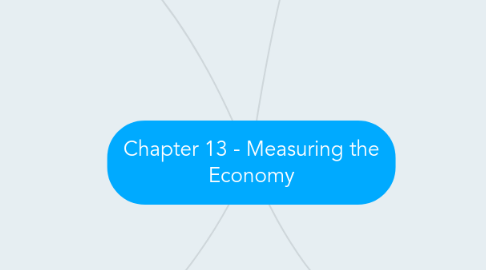Chapter 13 - Measuring the Economy
by JOSEPH WELLEN

1. Section 3 - What does the Unemployment Rate tell us about an Economy's health?
1.1. There are four main types of unemployment: Frictional, Structural, Seasonal, and Cyclical.
1.2. When the employment rate is high, the overall health of the economy is poor.
1.3. Unemployed people no longer pay income taxes, which can harm the economy.
1.4. The BLS interviews many households to see what kind of wealth each family has to see if they are unemployed.
1.5. Unemployment Rate- the percentage of the labor force that is not employed but is actively seeking work.
1.6. Frictional Unemployment- a type of unemployment that results when workers are seeking their first job or have left one job and are seeking another.
1.7. Structural Unemployment- a type of unemployment that results when the demand for certain skills declines, often because of changes in technology or increased foreign competition.
1.8. Seasonal Unemployment - a type of unemployment that results when businesses shut down or slow down for part of the year often because of weather.
1.9. Cyclical- a type of unemployment that results from a period of decline in the business cycle.
2. Section 4 - What does the Inflation Rate reveal about the Economy''s health?
2.1. The BLS uses the cost of living to track inflation.
2.2. If an economy has high inflation, it is not a healthy economy, and will encounter many problems.
2.3. There is gradual inflation in the United States every year. This is expected with this.
2.4. The cost of living is starting to go up in money terms, making everything to be more expensive for consumers to buy.
2.5. Inflation Rate- the percentage increase in the average price level of goods and services from one month or year to the next.
2.6. Deflation - a fall in the price of goods and services; the opposite of inflation
3. Section 5- How does the Business Cycle Relate to Economic Health?
3.1. The four phases of the business cycle: Expansion, Peak, Contraction, and Trough.
3.2. The business cycle is recognized by several indicators including leading, coincident, and lagging.
3.3. Our economy can go towards a recession when there is a negative experience on the United States around the world, like a terrorist bombing.
3.4. There is gradual inflation in the U.S. every year, This is to be expected.
3.5. Recession - a period of declining national economic activity, usually measured as a decrease in GDP for at least two consecutive quarters (six months).
3.6. Depression - a prolonged economic downturn characterized by plunging real GDP and extremely high unemployment
4. Section 2 - How do Economists Measure the Size of the Economy?
4.1. Economists use a country's Gross Domestic Product (GDP) to measure the size of the economy.
4.2. Economist also must account for inflation and population when dealing with the size of the economy.
4.3. GDP is useful when measuring economic growth, but does have limitations when trying to measure overall health of an economy.
4.4. GDP also measures the well-being of an economy of all people that are in it.
4.5. Gross Domestic Product- the market value of all final goods and services produced within a country during a given period of time.
4.6. Real Gross Domestic Product - a measure of a country's economic output (GDP) valued in constant dollars; real GDP reflects the effects of inflation.
4.7. Per Capita GDP - a nation's real GDP divided by is population; a measure of average economic output per person.


